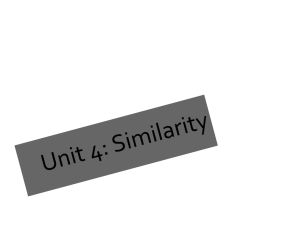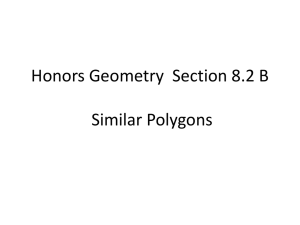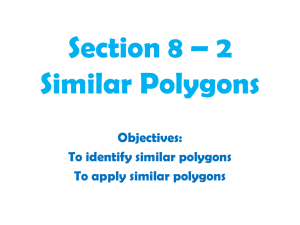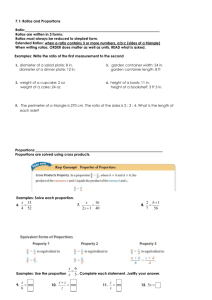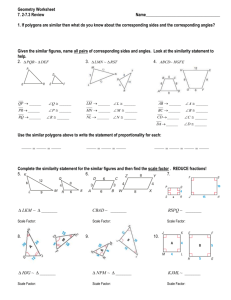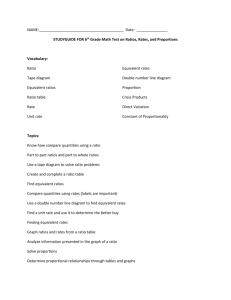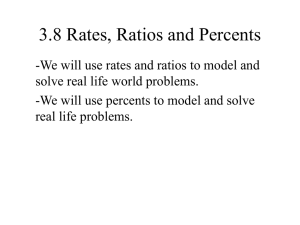Weinel_Ratios_Proportions
advertisement
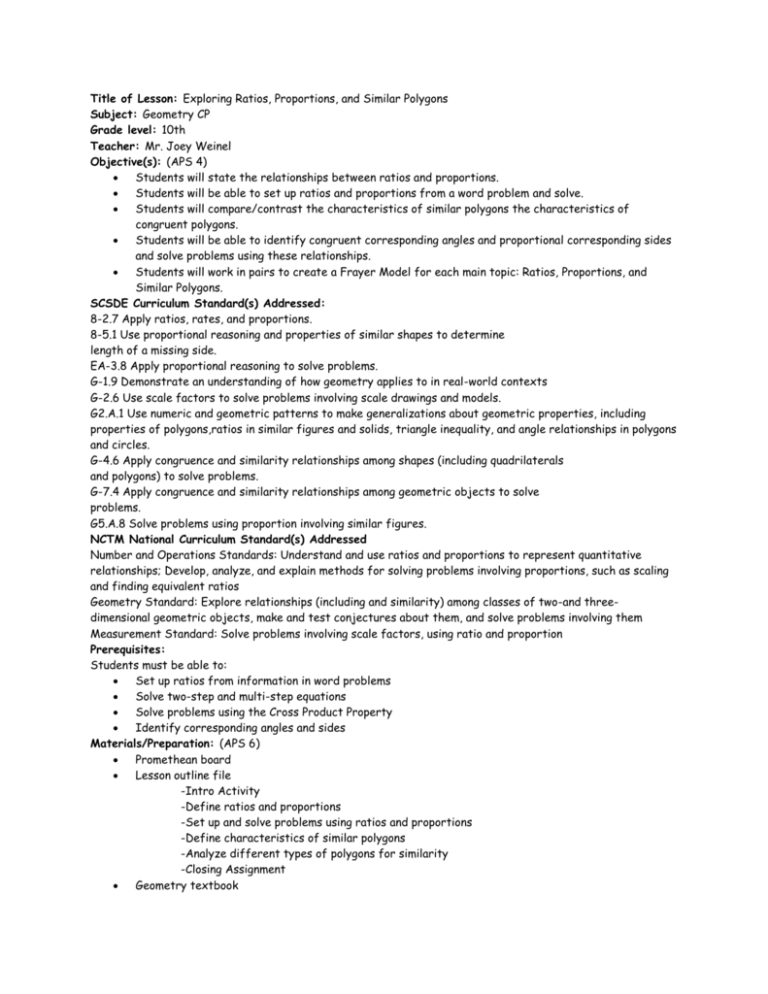
Title of Lesson: Exploring Ratios, Proportions, and Similar Polygons Subject: Geometry CP Grade level: 10th Teacher: Mr. Joey Weinel Objective(s): (APS 4) Students will state the relationships between ratios and proportions. Students will be able to set up ratios and proportions from a word problem and solve. Students will compare/contrast the characteristics of similar polygons the characteristics of congruent polygons. Students will be able to identify congruent corresponding angles and proportional corresponding sides and solve problems using these relationships. Students will work in pairs to create a Frayer Model for each main topic: Ratios, Proportions, and Similar Polygons. SCSDE Curriculum Standard(s) Addressed: 8-2.7 Apply ratios, rates, and proportions. 8-5.1 Use proportional reasoning and properties of similar shapes to determine length of a missing side. EA-3.8 Apply proportional reasoning to solve problems. G-1.9 Demonstrate an understanding of how geometry applies to in real-world contexts G-2.6 Use scale factors to solve problems involving scale drawings and models. G2.A.1 Use numeric and geometric patterns to make generalizations about geometric properties, including properties of polygons,ratios in similar figures and solids, triangle inequality, and angle relationships in polygons and circles. G-4.6 Apply congruence and similarity relationships among shapes (including quadrilaterals and polygons) to solve problems. G-7.4 Apply congruence and similarity relationships among geometric objects to solve problems. G5.A.8 Solve problems using proportion involving similar figures. NCTM National Curriculum Standard(s) Addressed Number and Operations Standards: Understand and use ratios and proportions to represent quantitative relationships; Develop, analyze, and explain methods for solving problems involving proportions, such as scaling and finding equivalent ratios Geometry Standard: Explore relationships (including and similarity) among classes of two-and threedimensional geometric objects, make and test conjectures about them, and solve problems involving them Measurement Standard: Solve problems involving scale factors, using ratio and proportion Prerequisites: Students must be able to: Set up ratios from information in word problems Solve two-step and multi-step equations Solve problems using the Cross Product Property Identify corresponding angles and sides Materials/Preparation: (APS 6) Promethean board Lesson outline file -Intro Activity -Define ratios and proportions -Set up and solve problems using ratios and proportions -Define characteristics of similar polygons -Analyze different types of polygons for similarity -Closing Assignment Geometry textbook Procedures: (APS 4, 5, 6, 7, 8, 9) Introductory Activity: Practice problems involving setting up ratios from information in word problems and identifying corresponding angles and sides in figures. Write as many ratios as you can for the following situations. Make sure to identify what your ratios state. 1. Bobby has a bag full of marbles that he keeps in his room. He has 35 red marbles and 25 green marbles. Find the ratio of red marbles to green marbles. 2. A geometry class has 14 boys and 10 girls in it. -Extension Questions: 1) How can you tell if two ratios are equivalent? -If Bobby has 10 red marbles and 5 green marbles in one bag, and another bag with 8 red marbles and 4 green marbles, what can you tell me about the ratios of red:green marbles in the two bags? Main Activity: 1. Define ratios and proportions 2. Guided problems using ratios and proportions to solve (see below) Individual problem set solving problems using ratios and proportions (see below) Explain characteristics of similar polygons 3. Corresponding angles are congruent, and corresponding sides are proportional - Define similarity ratio and similarity statement - Discuss difference between congruence and similar Guided examples with similar figures (see below) Analyze properties of similarity Reflexive, Symmetric, and Transitive Definitions: Ratio- compares two numbers by division e.g. 𝑎 𝑏 read as “a to b” What ways do you know how to write a ratio? 𝑎 𝑏 can also be written as a:b Proportion- an equation stating two ratios are equal e.g. 𝑎 𝑏 = 𝑐 𝑑 In the proportion above, how would you solve for a? how about b? c? d? Guided Practice: 1) David read 40 pages of a book in 50 minutes. At this pace, how many pages should he be able to read in 80 minutes? 2) 17 19 = 𝑥 13 What are some situations that you can come up with that the above proportion could represent? What is the variable x in this situation? Solve the proportion for this variable. Individual Problem Set for Ratios and Proportions 1) Given 4x=10y, find the ratio of x to y in simplest form 2) The ratio of the sides of a triangle is 3:4:5 and its perimeter is 72 ft. How long is each side? Come up with a story describing the following proportions. Be sure to clearly define your variables. Solve the proportions for the unknown variable and give all possible answers. 3) 5 𝑦 45 4) = 63 𝑥+2 4 9 = 𝑥+2 Characteristics of Similar Polygons Observing the similar quadrilaterals ABCD and EFGH and the given information, what do you think are necessary characteristics for polygons to be similar? Corresponding angles are congruent The ratios of corresponding sides must be equal - The ratio of the corresponding sides is referred to as the similarity ratio - How does this definition differ from congruent polygons? o Congruent figures are similar with a similarity ratio of 1 Each corresponding side of the larger figure ABCD is twice the length of the side of smaller figure EFGH so the similarity ratio from ABCD:EFGH is? 2:1 So we write ABCD~EFGH, this is the similarity statement. ~ means is similar to What kind of information are we given from the figures above? What is the necessary information to identify whether or not two figures are similar? Therefore, are the quadrilaterals similar? Why or why not? Properties of Similarity For ABCD~EFGH~IJKL in a 4:2:1 ratio How can I draw these figures to represent them correctly according to the similarity ratio? -Draw them on Promethean board as students describe Reflexive:”is similar to itself” AB:AB, any side is similar to itself with a similarity ratio of 1 Symmetric: “if A is similar to B then B is similar to A” AB:EF has a similarity ratio of 2:1 then EF:AB is similar with a ratio of 1:2 Transitive: “If A is similar to B and B is similar to C then A is similar to C” If AB:EF with a similarity ratio of 2:1 and EF:IJ with a similarity ratio of 2:1 then AB:IJ with a similarity ratio of 4:1. Closure: 1. 2. Students will work in pairs to create a Frayer model for each main topic covered: Ratio, Proportion, and Similarity This is an important task because it’s important to know the definitions of each as well as differentiate these closely related topics. Students will work individually on the closing problem set involving solving problems using ratios, proportions, and properties of similar figures. (attached) Frayer Model Closing Problem Set Create a situation that fits the following proportions. Define your variables appropriately and solve for all possible answers. 1) 𝑥 40 = 2 16 2) 𝑌 3 = 27 𝑌 3) Given that 6x=27y, find the ratio of y:x in simplest terms 4) The ratio of the side lengths of an isosceles triangle is 4:4:7 and its perimeter is 52.5 cm. What is the length of the base of the triangle? 5) Identify the pairs of congruent angles and corresponding sides. Determine whether the polygons are similar. If so, write the similarity ratio and a similarity statement. 6) Using the definitions of congruence, similarity, and the characteristics of the given polygons: state whether each statement is sometimes, always, or never true. 1) Two right triangles are similar 2) Two squares are similar 3) A parallelogram and a trapezoid are similar 4) If two polygons are congruent, they are also similar 5) If two polygons are similar, they are also congruent Assessment: (APS 3) Informally I will assess student understanding through the discussion/extension questions included throughout the lesson. The classwork activities assigned will be collected as a daily grade and will reflect the level of student understanding. Material will be included in mid-chapter quiz and end of chapter test given by Mr. Cochran. Adaptations: (APS 6, 7) Throughout the lesson the discussion/extension questions will be used to check for understanding. Also throughout the definitions of the similarity postulates and later in the proofs of similar triangles justification will be stated for each step as shown. The classwork problems include various givens or situations so students can show their level of understanding and ability to apply their knowledge to different contexts. Several guided exercises are included to show steps where students may struggle and to give them a chance to ask questions and to reinforce understanding for other students. Follow-up Lessons/Activities: (APS7) The properties of similar polygons will be specifically applied to triangles in the following lesson. Reflection: Complete separately after lesson is taught. Consider your decisions in planning the lesson (materials, procedures, strategies); Consider the impact the lesson had on the students (Did they achieve the objective(s)?, Did your procedures seem effective?); Finally, consider areas for improvement if lesson were taught again, and what areas were most successful.
